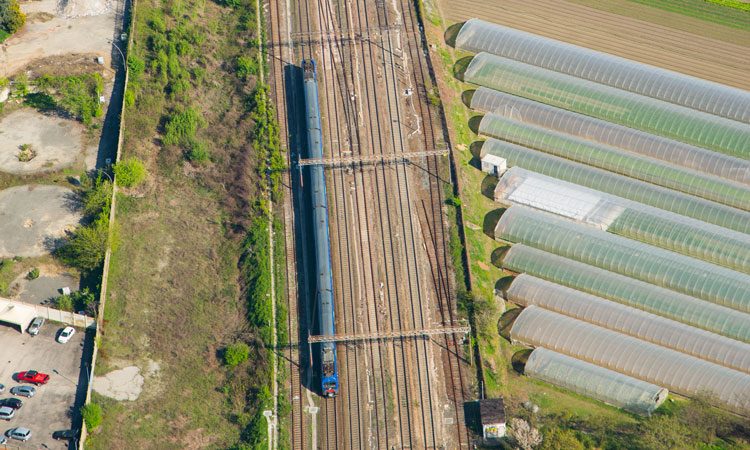Can space technology be used to transform the future of rail?
Posted: 2 December 2019 | Carlo Des Dorides, Josef Doppelbauer | No comments yet
Satellite-based technologies will shape the future of European and global railways. While many traditional rail technologies will be gradually phased out, satellite technology opens up new possibilities to facilitate and accelerate the digitalisation of rail – providing scalable solutions for accurate railway positioning, which is essential for safety, as well as improving the user experience for passenger and freight customers. This article explores how the introduction of global navigation satellite system (GNSS) positioning technologies will make rail infrastructure more cost efficient and give a further boost to the global success story of exporting European railway signalling technology.


A joint approach
Working together to satisfy the demands of an increasingly digitalised world, the European Global Navigation Satellite Systems Agency (GSA), the European Union Agency for Railways (ERA), and the Shift2Rail Joint Undertaking (S2R JU) joined forces to take a further step towards the exploitation of satellite technology in future railway systems at a high-level conference in Vienna in March 2019. Both the GSA and S2R JU have a key role in leading innovation activities and engaging with the wide range of rail and space stakeholders involved, while ERA is orchestrating the process from a regulatory point of view within the framework of the European Railway Traffic Management System (ERTMS).
The two-day event entitled ‘Space for innovation in rail’ gathered rail stakeholders, industry and user communities to share a vision and roadmap of space technologies for the future of railways in Europe, examine the role of different stakeholders in innovation and digitalisation, and take stock of progress in the implementation of GNSS for rail applications.
Global navigation satellite technology already plays a significant role in the railway sector and is adopted mainly in non-safety relevant applications within asset and traffic management or passenger information services. Satellite positioning has also been recognised as one of the key game-changers in a Memorandum of Understanding signed in 2016 between the European Commission, ERA and the European rail sector associations concerning cooperation for the deployment of ERTMS. The challenges and business aspects for future satellite positioning adoption within the sector were a key discussion point at the Vienna event.
With the continuing deployment and near-term completion of Galileo and the success of Europe’s space-based positioning augmentation system, EGNOS, the basis for more wide-spread implementation in the rail sector is now laid.
Making the system less complex, more reliable and affordable
use of GNSS has the potential to make rail systems less complex, cheaper, more reliable and responsive, while maintaining the highest standards of safety. But the big question is how to accelerate the roll-out of space technology in the railways? There is a need to define future system architecture and move faster from the laboratory onto the track. In addition, of course, a sound business case is required, and the right incentives need to be put in place.
The use of space-based technologies can have an impact across the industry from assisting autonomous train operations, whether on commercial lines or in the shunting yard, to enhancing customer information services, and optimising maintenance scheduling to ensure all components of the system operate as effectively and efficiently as possible.
Speaking at the event, Carlo des Dorides, Executive Director of the GSA said that the question was “Not if GNSS will provide a solution, but rather ‘how’?” He noted that over 600 procedures in 360 airports in Europe were now enabled by EGNOS and that Galileo has the potential to change the rail landscape in the same way EGNOS had changed the civil aviation scenario, becoming the benchmark satellite navigation system.
The EGNOS augmentation system is already a major success for safety-relevant transport applications, providing services for aviation and could also deliver the similar kind of service for rail. However, questions such as the exact service provision requirements and certification need to be answered. Fortunately, experience gained in other sectors could ease adoption in rail.
Carlo des Dorides said: “Europe’s investment in satellite navigation is already benefitting many sectors including mobility, smart cities, farming, mobile applications and more. Our innovative projects in rail show that satellite-based positioning can make rail transport more efficient and safer. It is fundamental now that railway undertakings, infrastructure managers and the EU rail industry are converging on solutions to be implemented within the ERTMS evolution to help ensure interoperability and export of European technologies. It is reassuring to see all stakeholders eager to discuss how to leverage the potential of Galileo and EGNOS for the future of rail transport in Europe. Like space, the next generation of rail operation will know no borders!”
The use of satellite systems also chimes with other pressing priorities in the sector. Josef Doppelbauer, Executive Director of ERA stressed the need to decarbonise the transport system and sees the adoption of space-based technologies as a “unique opportunity to take cost out of the industry and simplify infrastructure.” He also noted that innovation is quickly absorbed in other transport sectors such as automotive and highlights interoperability and standardisation as the preconditions for true pan-European innovation in the sector.
From a regulatory perspective, the integration of GNSS technologies is a major part of rail’s contribution to saving the planet by providing the sustainable mobility and transport modes essential for our society and economy. In terms of CO2 emissions per passenger kilometre train travel is already 10 times better than air travel. Satellite-based technology can contribute significantly to savings within rail signalling systems. GNSS can reduce the need for track side infrastructure, while delivering massive data redundancy, which will be a significant influence on establishing a robust safety case.
Josef Doppelbauer said: “Increasing efficiency and competitiveness are the name of the game for railways. For this reason, railways need to innovate and in order to be commercially viable, innovation in rail needs to be based on interoperability. Satellite navigation provides very attractive capabilities for safe train operation that do not require expensive trackside installation, with GNSS opening up new ways, but also challenges in demonstrating safety across the system. GNSS has the potential to revolutionise the European Railway Traffic Management System (ERTMS).”
Carlo Borghini, Executive Director of the Shift2Rail JU sees space technologies as the key to increasing capacity and efficiency in the system by boosting the quality and consistency of train localisation. He emphasises the need to look forward and accelerate results and implementation, while ensuring safety. Space technology is about collaboration across sectors and Borghini looks forward to the development and presentation of a new European technology roadmap for rail within the next year including European GNSS.
Carlo Borghini said: “Shift2Rail is pleased to move forward this European cooperation by accelerating research and innovation solutions for the application of GNSS for rail. It is only by involving all actors that new technologies and solutions can deliver interoperability by design, meeting customer needs and overcoming operational barriers.”
Challenges and next steps
While GNSS could be a game changer for rail in terms of operational and infrastructure cost efficiency and safety, any implementation must also ensure interoperability within the European rail network. In addition, all new rail systems must be certified and there was a significant question about who would do this and how the new GNSS-based solutions might be financed. For example, in the aviation sector the GSA has supported projects that co-finance necessary avionics updates for the operators.
Space technologies offer the potential to address major challenges that face the sector if it is to make the impact for sustainable mobility that society requires: reducing rail system costs by a factor of 10, increasing system capacity with smart technology and meeting the mixed traffic challenge where slow freight and higher speed passenger services must share tracks. However, if all the challenges can be solved this would represent a giant leap forward towards sustainable mobility.
Clearly, European research on GNSS for rail signalling is extremely synchronised with a high level of coordination to achieve inclusion of GNSS in the future evolution of ERTMS. GNSS satisfies all the market needs being stable, fully interoperable, and opening possibilities for reductions in both capital and operating expenditure for ERTMS implementation on specific categories of track, while maintaining interoperability, safety and improving the flexibility and attractiveness of ERTMS for users in Europe and beyond.
But what are the next steps for implementation of a GNSS-based ERTMS?
An analysis of European GNSS performance in the rail environment carried out by the main EU railway signalling industry players within the GSA project portfolio will feed into a definition of a system architecture in later-2019 with a first operational pilot line planned to be introduced in Italy in 2020. In parallel, further work on the cost-benefit of GNSS is in hand, but more work is required to specify the exact role of the EGNOS service and its certification, as was done before within the aviation sector. The three European agencies are committed to working closely together to demonstrate and implement space-based systems in the rail sector and ensure that this massive opportunity to entrench rail as the sustainable backbone of our future transport systems is delivered.
SHIFT2RAIL JOINT UNDERTAKING
Shift2Rail is the first European rail initiative to seek focused research and innovation (R&I) and market-driven solutions by accelerating the integration of new and advanced technologies into innovative rail product solutions. Shift2Rail promotes the competitiveness of the European rail industry and meets changing EU transport and mobility needs. R&I carried out under this Horizon 2020 initiative develops the necessary technology to complete the Single European Railway Area (SERA). Within this framework, Shift2Rail is working on delivering solutions for a fail-safe, multi-sensor train positioning system applying Global Navigation Satellite Systems (GNSS) technology to the current ERTMS/ETCS core. It will enable the improvement of the identification of train location and integrity information, while reducing overall costs for the system.
www.shift2rail.org
EUROPEAN GLOBAL NAVIGATION SATELLITE SYSTEMS AGENCY (GSA)
As an official European Union Regulatory Agency, the European GNSS Agency (GSA) is in charge of managing operations and service provision of Galileo and EGNOS, ensuring that European citizens get the most out of Europe’s satellite navigation programmes in terms of innovation, competitiveness, economic growth, and benefit to users. The GSA is Europe’s link between space technology and user needs, it works together with institutions, industry, service providers, SMEs, entrepreneurs, and research institutions to respond to users’ needs and provide a satellite navigation service able to ignite a broad range of applications, and serve the user communities, including the European rail community and European rail passengers.
www.gsa.europa.eu
EUROPEAN UNION AGENCY FOR RAILWAYS
The Agency is the system authority for ERTMS, ensuring the specifications are maintained and managed in accordance with the principles of stability and compatibility, and helping the implementations of the system according to the principles of compliance and discipline. The new roles defined in the 4th Railway Package for the Agency in delivering vehicle authorisations and approvals to ERTMS trackside projects allows a strengthened leadership in the efficient implementation of the framework and of application of the standards. The Agency works institutionally with the sector organisations and, for ERTMS, has dedicated actions on technical, safety and operational areas. In the field of railway communications, the Agency defines the roadmap for the evolution of operational radio in view of the planned GSM-R life expectancy, aiming at a definition of the new radio communication systems.
www.era.europa.eu


CARLO BORGHINI has been the Shift2Rail Joint Undertaking Executive Director since February 2016, responsible for the overall management of its activities. Prior to this, Carlo held senior corporate level management positions in both private and international organisations. He was Deputy Executive Director for the SESAR Joint Undertaking (SJU) from 2008 to 2014, and prior to this was Director and Chief Financial Officer (CFO) for the International Fund for Agricultural Development (IFAD), a specialised Agency of the United Nations. Carlo holds a master’s degree equivalent in Business Economics and speaks Italian, French and English.




Issue
Related topics
Related organisations
European Global Navigation Satellite Systems Agency (GSA), Europe’s Rail Joint Undertaking (EU-Rail)








